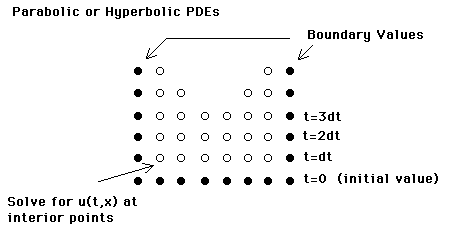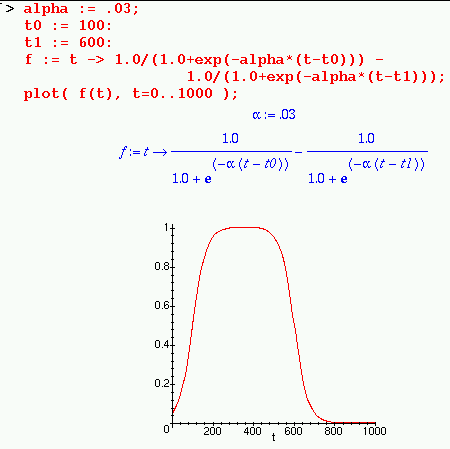PDEs are traditionally classified into three broad categories: elliptic, parabolic and hyperbolic equations. However, from the numerics point of view, PDEs divide into static equations (elliptic) and time dependent equations (parabolic & hyperbolic).
The hyperbolic and parabolic equations represent initial value problems. The diffusion equation (parabolic)
![]()
(D is the diffusion coefficient) is such that we ask for what is the
value of the field (wave)
![]() at a later time t knowing the field at an initial time t=0
and subject to some specific boundary conditions at all times.
at a later time t knowing the field at an initial time t=0
and subject to some specific boundary conditions at all times.

The domain may be 1-D, 2-D, or 3-D. This equation might represent a heat diffusion problem in which the temperature within the domain is sought at all times, starting from a given temperature field at the initial time, and preserving the temperature at the boundary of the domain. In addition, a source term S(x,t) could be added to the right hand side of the equation. If u(x,t) represents a temperature field, then S(x,t) would represent a heat source.
The parallelization of the solution of a PDE of parabolic or hyperbolic PDEs is
obtained through domain decomposition. However, in this case, the Domain Decomposition applies
only to the space variables.
The time evolution is essentially sequential,
![]() is obtained from
is obtained from ![]() ,
which can not be parallelized.
,
which can not be parallelized.
We will model heat diffusion through a 2-D plate. The parabolic PDE to solve is
∂ u(x,y,t) / ∂ t = ∂2 u(x,y,t) / ∂x2 + ∂2 u(x,yt) / ∂y2 + s(x,y,t)
Dirichlet boundary conditions are assumed, the temperature being fixed at the top and bottom of the plate, utop and ubot , and on the left and right sides, the latter being proportional to distance
uright = uleft = ubot + deltat y where deltat = ( utop - ubot ) / L and L=height of plate
A source of heat within the domain is assumed to exist. This source of heat may depend on time.
A finite difference scheme is applied to solve the diffusion equation. First, discretization of the domain is performed. We use hx = hy = h = 0.01 and dt = 0.0002 to perform this discretization. We use a rectangular domain with Nx ~ 2 Ny to acomodate the shape of the source. In what follows, i and j will specify x and y respectively, while the superscript k will specify the time slice.
This diffusion PDE is written in finite difference form as
(u
k+1 ij - ukij ) / dt =
1/2 ( δ2x u k+1 ij + δ2y u k+1 ij + δ2x u k ij + δ2y u k ij ) + 1/2 ( S k+1ij + Skij )
where
δ2x
u k+1 ij =
( u k+1 i+1
j - 2 u k+1 ij + u k+1 i-1 j
) / h2
and the same for the time slice specified by k. Let r = dt / ( 2 h 2 ). The terms at time k+1 are separated from those at time k to yield
(
1+4r ) u k+1 ij -
r ( u k+1
i+1 j + u k+1
i-1 j + u k+1 i j+1 + u k+1 i
j-1) = d k ij
where
d k
ij = r ( u k i+1
j + u k i-1 j
+ u k i j+1 + u k i j-1) +
These equations form a linear system of equations for u k+1. These are solved iteratively for each time slice. The lattice is swept repetitively, solving for u k+1 ij until convergence is obtained.
u k+1
ij = ( r
( u k+1 i+1 j
+ u k+1 i-1 j +
u k+1 i j+1 + u k+1 i j-1) +
Download the tar file Diffusion_2d.tar
containing a directory structure on any serial computer
where you can use VisIt.
Expand it via:
tar -xvf Diffusion_2d.tar
The directory Difusion_2d contains two directories: diffusion and source.
The code 2d_diffusion.c in the directory diffusion implements the above scheme to solve a 2D diffusion problem. The steps in the code are:
The code is compiled and executed via
gcc 2d_diffusion.c -lm -o 2d_diffusion
./2d_diffusion N_x N_y
where N_x and N_y are the (arbitrary) number of grid points - image size; a ratio 2 to 1 is recommended for the grid sizes in x and y directions. Good numbers to use are ( 700 - 400 ). The code defaults to scan over 3500 time steps.
The code 2d_diffusion.c requires visit_writer.c and visit_writer.h with which it links. This package is used to store the field at each specified time slice in VTK file format in a sub-directory movie. VisIt can form a movie out of these files labeled by a frame number.
Notes about the code 2d_diffusion.c:
Better code:
The code Diffusion_2d_pipe_python.tar makes the movie via our python utilities. This makes the movie in real time!
The source:
The code 2d_diffusion.c needs the code 2d_source.c found in the sub-directory source. This code generates the source term to include in the equations. The sub-directory source also contains 2d_source_main.c to see the source. It is compiled and executed via
gcc 2d_source_main.c -lm -o 2d_source
./2d_source
The shape of the source is chosen to represent the word "DREXEL". This word is discretized in the function drexel_name() to occupy a good fraction of the domain. The shape of each letter is 1 pixel large. This shape is then enlarged via a smoothing procedure (function smooth_text() ). This is done via a simple sum of the neighboring points adjacent to each pixel in the interior domain. This produces the following source geometry ( in a 200 x 100 grid case )

Smoothing passes are repeated to obtain the desired widths for the source ( 4 times in the code ). The function see_image() displays the source geometry ( image above ).
A time dependence is introduced in the code. A graphical representation (through Maple) follows:
